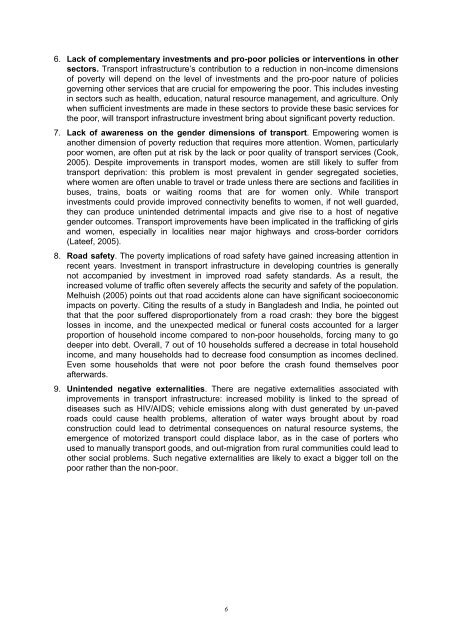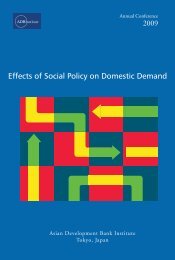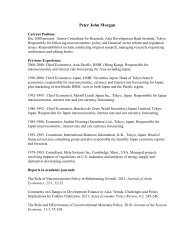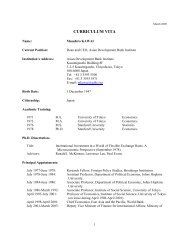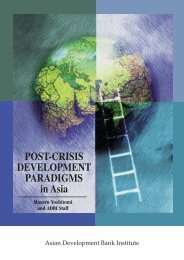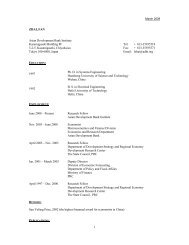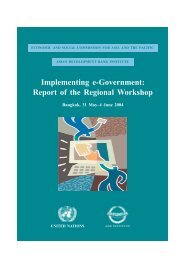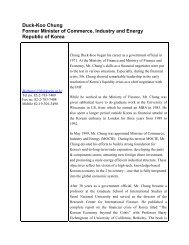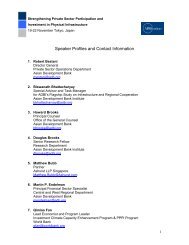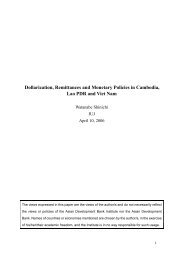Transport Infrastructure and Poverty Reduction - Asian Development ...
Transport Infrastructure and Poverty Reduction - Asian Development ...
Transport Infrastructure and Poverty Reduction - Asian Development ...
- No tags were found...
Create successful ePaper yourself
Turn your PDF publications into a flip-book with our unique Google optimized e-Paper software.
6. Lack of complementary investments <strong>and</strong> pro-poor policies or interventions in othersectors. <strong>Transport</strong> infrastructure’s contribution to a reduction in non-income dimensionsof poverty will depend on the level of investments <strong>and</strong> the pro-poor nature of policiesgoverning other services that are crucial for empowering the poor. This includes investingin sectors such as health, education, natural resource management, <strong>and</strong> agriculture. Onlywhen sufficient investments are made in these sectors to provide these basic services forthe poor, will transport infrastructure investment bring about significant poverty reduction.7. Lack of awareness on the gender dimensions of transport. Empowering women isanother dimension of poverty reduction that requires more attention. Women, particularlypoor women, are often put at risk by the lack or poor quality of transport services (Cook,2005). Despite improvements in transport modes, women are still likely to suffer fromtransport deprivation: this problem is most prevalent in gender segregated societies,where women are often unable to travel or trade unless there are sections <strong>and</strong> facilities inbuses, trains, boats or waiting rooms that are for women only. While transportinvestments could provide improved connectivity benefits to women, if not well guarded,they can produce unintended detrimental impacts <strong>and</strong> give rise to a host of negativegender outcomes. <strong>Transport</strong> improvements have been implicated in the trafficking of girls<strong>and</strong> women, especially in localities near major highways <strong>and</strong> cross-border corridors(Lateef, 2005).8. Road safety. The poverty implications of road safety have gained increasing attention inrecent years. Investment in transport infrastructure in developing countries is generallynot accompanied by investment in improved road safety st<strong>and</strong>ards. As a result, theincreased volume of traffic often severely affects the security <strong>and</strong> safety of the population.Melhuish (2005) points out that road accidents alone can have significant socioeconomicimpacts on poverty. Citing the results of a study in Bangladesh <strong>and</strong> India, he pointed outthat that the poor suffered disproportionately from a road crash: they bore the biggestlosses in income, <strong>and</strong> the unexpected medical or funeral costs accounted for a largerproportion of household income compared to non-poor households, forcing many to godeeper into debt. Overall, 7 out of 10 households suffered a decrease in total householdincome, <strong>and</strong> many households had to decrease food consumption as incomes declined.Even some households that were not poor before the crash found themselves poorafterwards.9. Unintended negative externalities. There are negative externalities associated withimprovements in transport infrastructure: increased mobility is linked to the spread ofdiseases such as HIV/AIDS; vehicle emissions along with dust generated by un-pavedroads could cause health problems, alteration of water ways brought about by roadconstruction could lead to detrimental consequences on natural resource systems, theemergence of motorized transport could displace labor, as in the case of porters whoused to manually transport goods, <strong>and</strong> out-migration from rural communities could lead toother social problems. Such negative externalities are likely to exact a bigger toll on thepoor rather than the non-poor.6


